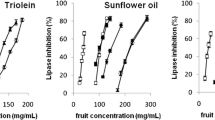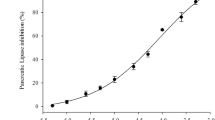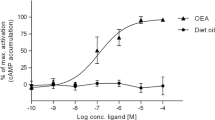Abstract
Background
Fucoxanthin isolated from edible seaweeds and its metabolite fucoxanthinol have been recently found to have anti-obesity effects, but the mechanism is not fully understood.
Aim of study
We investigated the effects of these carotenoids on the absorption of triglycerides in conscious rats implanted with cannulae into a lymph duct and the portal or jugular vein.
Methods
A duodenal infusion of 1 ml of test oil emulsion with or without 2 mg of fucoxanthin or fucoxanthinol was administered in the lymph duct and the portal (Experiment 1) or the jugular vein (Experiment 2) cannulated rats. The test oil contained 10% soybean oil (Experiment 1) and pre-digested 10% soybean oil (Experiment 2). The inhibitory activities of these carotenoids on pancreatic lipase activity were measured in vitro.
Results
Increases in lymphatic and blood triglyceride levels were much lower in the two carotenoid-treated groups than in the carotenoid-free group, indicating that these carotenoids inhibit triglyceride absorption. The total amounts of triglycerides released into the lymph after 4 h in the carotenoid-free, fucoxanthin and fucoxanthinol groups were 113.5, 59.4 and 53.1 μmol, respectively. The inhibitory effects of carotenoids were completely abolished after an infusion of pre-digested soybean oil containing carotenoids. Furthermore, these carotenoids inhibited pancreatic lipase activity in vitro. Regarding absorptive route, we found that fucoxanthinol, but not fucoxanthin, appeared in lymph fluid, whereas neither carotenoid was detected in portal blood.
Conclusion
These results show that these two marine carotenoids inhibit lipase activity in the gastrointestinal lumen and suppress triglyceride absorption, and fucoxanthin was converted to fucoxanthinol in the intestine and released into the lymph.




Similar content being viewed by others
References
Asai A, Sugawara T, Ono H, Nagao A (2004) Biotransformation of fucoxanthinol into amarouciaxanthin A in mice and HepG2 cells: formation and cytotoxicity of fucoxanthin metabolites. Drug Metab Dispos 32:205–211
Asai A, Yonekura L, Nagao A (2008) Low bioavailability of dietary epoxyxanthophylls in humans. Br J Nutr 100:273–277
Folch J, Lees M, Sloane Stanley GH (1956) A simple method for isolation and purification of total lipids from animal tissues. J Biol Chem 226:497–509
Garcia SB, Barros LT, Turatti A, Martinello F, Modiano P, Ribeiro-Silva A, Vespúcio MV, Uyemura SA (2006) The anti-obesity agent Orlistat is associated to increase in colonic preneoplastic markers in rats treated with a chemical carcinogen. Cancer Lett 240:221–224
Guerciolini R, Radu-Radulescu L, Boldrin M, Dallas J, Moore R (2001) Comparative evaluation of faecal fat excretion induced by orlistat and chitosan. Obes Res 9:364–367
Harris KL, Felts JM (1970) Kinetics of chylomicron triglyceride removal from plasma in rats: a comparison of the anesthetized and the unanesthetized states. J Lipid Res 11:75–81
Hosokawa M, Kudo M, Maeda H, Kohno H, Tanaka T, Miyashita K (2004) Fucoxanthin induces apoptosis and enhances the antiproliferative effect of the PPARgamma ligand, troglitazone, on colon cancer cells. Biochim Biophys Acta 1675:113–119
Hvizdos KM, Markham A (1999) Orlistat: a review of its use in the management of obesity. Drugs 58:743–760
Karpe F (1999) Postprandial lipoprotein metabolism and atherosclerosis. J Intern Med 246:341–355
Kim JM, Araki S, Kim DJ, Park CB, Takasuka N, Baba-Toriyama H, Ota T, Nir Z, Khachik F, Shimidzu N, Tanaka Y, Osawa T, Uraji T, Murakoshi M, Nishino H, Tsuda H (1998) Chemopreventive effects of carotenoids and curcumins on mouse colon carcinogenesis after 1,2-dimethylhydrazine initiation. Carcinogenesis 19:81–85
Kotake-Nara E, Kushiro M, Zhang H, Sugawara T, Miyashita K, Nagao A (2001) Carotenoids affect proliferation of human prostate cancer cells. J Nutr 131:3303–3306
Luddy FE, Barford RA, Herb SF, Magidman P, Riemenschneider RW (1964) Pancreatic lipase hydrolysis of triglycerides by a semimicro technique. J Am Oil Chem Soc 41:693–696
Maeda H, Hosokawa M, Sashima T, Funayama K, Miyashita K (2005) Fucoxanthin from edible seaweed, Undaria pinnatifida, shows antiobesity effect through UCP1 expression in white adipose tissues. Biochem Biophys Res Commun 332:392–397
Maeda H, Hosokawa M, Sashima T, Takahashi N, Kawada T, Miyashita K (2006) Fucoxanthin and its metabolite, fucoxanthinol, suppress adipocyte differentiation in 3T3-L1 cells. Int J Mol Med 18:147–152
Matsumoto M, Chiji H, Hara H (2005) Intestinal absorption and metabolism of a soluble flavonoid, alphaG-rutin, in portal cannulated rats. Free Radic Res 39:1139–1146
Mattson FH, Volpenhein RA (1964) The digestion and absorption of triglycerides. J Biol Chem 239:2772–2777
Mu H, Høy CE (2001) Intestinal absorption of specific structured triacylglycerols. J Lipid Res 42:792–798
Nishimukai M, Hara H, Aoyama Y (2003) Enteral administration of soyabean lecithin enhanced lymphatic absorption of triacylglycerol in rats. Br J Nutr 90:565–571
Nomura T, Kikuchi M, Kubodera A, Kawakami Y (1997) Protondonative antioxidant activity of fucoxanthin with 1, 1-diphenyl-2-picrylhydrazyl (DPPH). Biochem Mol Biol Int 42:361–370
Raederstorff DG, Schlachter MF, Elste V, Weber P (2003) Effect of EGCG on lipid absorption and plasma lipid levels in rats. J Nutr Biochem 14:326–332
Ros E (2000) Intestinal absorption of triglyceride and cholesterol. Dietary and pharmacological inhibition to reduce cardiovascular risk. Atherosclerosis 151:357–379
Shiratori K, Ohgami K, Ilieva I, Jin XH, Koyama Y, Miyashita K, Kase S, Ohno S (2005) Effects of fucoxanthin on lipopolysaccharide-induced inflammation in vitro and in vivo. Exp Eye Res 81:422–428
Shishikura Y, Khokhar S, Murray BS (2006) Effects of tea polyphenols on emulsification of olive oil in a small intestine model system. J Agric Food Chem 54:1906–1913
Sugawara T, Baskaran V, Tsuzuki W, Nagao A (2002) Brown algae fucoxanthin is hydrolyzed to fucoxanthinol during absorption by Caco-2 human intestinal cells and mice. J Nutr 132:946–951
Sugiyama H, Akazome Y, Shoji T, Yamaguchi A, Yasue M, Kanda T, Ohtake Y (2007) Oligomeric procyanidins in apple polyphenol are main active components for inhibition of pancreatic lipase and triglyceride absorption. J Agric Food Chem 55:4604–4609
Toyoda-Ono Y, Yoshimura M, Nakai M, Fukui Y, Asami S, Shibata H, Kiso Y, Ikeda I (2007) Suppression of postprandial hypertriglyceridemia in rats and mice by oolong tea polymerized polyphenols. Biosci Biotechnol Biochem 71:971–976
Warden BA, Smith LS, Beecher GR, Balentine DA, Clevidence BA (2001) Catechins are bioavailable in men and women drinking black tea throughout the day. J Nutr 131:1731–1737
Author information
Authors and Affiliations
Corresponding author
Rights and permissions
About this article
Cite this article
Matsumoto, M., Hosokawa, M., Matsukawa, N. et al. Suppressive effects of the marine carotenoids, fucoxanthin and fucoxanthinol on triglyceride absorption in lymph duct-cannulated rats. Eur J Nutr 49, 243–249 (2010). https://doi.org/10.1007/s00394-009-0078-y
Received:
Accepted:
Published:
Issue Date:
DOI: https://doi.org/10.1007/s00394-009-0078-y




